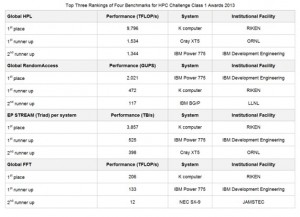Kikuo Hayakawa, NOST Tokyo
Origineel gepubliceerd op de site van Agentschap NL.
Samenvatting
Tijdens de HPC Challenge Awards 2013 op 22 november 2013 kwamen Japanse supercomputers weer als beste uit de bus qua prestaties en efficiënt energiegebruik. De Japanse K computer bereikte de nummer één positie in Class 1 en Class 2 van de Award. De prijs ging naar RIKEN, de Universiteit van Tsukuba en Fujitsu. Een dag eerder kwam de Japanse supercomputer TSUBAME-KFC, die ontwikkeld werd door het Tokyo Institute of Technology, op de eerste plaats met 4,5 gigaflops/watt, wat deze computer tot de meest energiezuinige supercomputer maakt. Het ministerie van onderwijs en wetenschappen is van plan een nieuw project te starten voor de ontwikkeling van de volgende generatie supercomputers, die in 2020 operationeel moet worden.
Details
RIKEN, the University of Tsukuba and Fujitsu received top ranks in three of the four benchmarks of the 2013 HPC Challenge* Class 1 Awards for the performance of the K computer** (Fig1). The first-place rankings were received in the following three benchmarks used for evaluating the all-around performance of a supercomputer: 1) Global HPL, which measures the floating point rate of execution for solving a linear system of equations; 2) EP STREAM (Triad) per system, which measures sustainable memory bandwidth and the corresponding computation rate for simple vector kernels; and 3) Global FFT, which measures the floating point rate of execution of double precision complex one-dimensional Discrete Fourier Transform. With this, the K computer ranked first, for the third consecutive year from 2011 to 2013, in the HPC Challenge Class 1 Awards. (1) Furthermore, RIKEN and the University of Tsukuba received the prize in the HPC Challenge Class 2 Awards, which recognize the overall performance of a programming language. This recognition is based on performance results measured using the K computer for implementations of the high-performance supercomputer parallel programming language XcalableMP***, which was jointly developed by RIKEN and the University of Tsukuba. This is the first time a Japanese organization has received the award. Also on 21 November 2013, the Green500 list was announced. Heterogeneous supercomputing systems totally dominate the top 10. (2) A Japanese supercomputer TSUBAME-KFC developed by Tokyo Institute of Technology tops the list with an efficiency of 4.5 gigaflops/watt. TSUBAME-KFC is the most energy-efficient supercomputer, followed by Wilkes, a supercomputer housed at Cambridge University (the second) and HA-PACS TCA system at The University of Tsukuba (the third). The awards of HPC Challenge and the Green500 were announced in Denver, Colorado, USA at SC13, the International Conference for High Performance Computing, Networking, Storage and Analysis.
For the next step, the Japanese government is motivated to develop the next generation of the K computer. Actually, the K computer is currently the world’s fourth-fastest computer in the world, which used be the fastest in 2011. In 2014, the Japanese Ministry of Education, Culture, Sports, Science and Technology (MEXT) will launch a new project of the next generation supercomputer starting operations by 2020. The next generation supercomputer will be 100 times faster than the K computer, which enables one quintrillion computations per second. (4)
Table 1. Top Three Ranking of Four Benchmarks of HPC Challenge Class Awards 2013 (source: Fujitsu)
*) HPC Challenge Awards
The HPC Challenge benchmarks are benchmark programs designed to evaluate the overall performance of supercomputers in terms of processing performance in 28 tests derived from frequently used computational patterns in the field of scientific computation. The HPC Challenge Awards are evaluated based on the HPC Challenge benchmarks. There are two classes of awards: Class 1, which measures benchmark performance values, and Class 2, which measures the productivity of programming language implementations. The Class 1 awards consist of the following four benchmarks, each of which evaluates the performance of key system components (CPU computational performance, memory access performance, network transmission performance).
- Global HPL: operating speed in solving large-scale simultaneous linear equations
- Global RandomAccess: random memory access performance in parallel processing
- EP STREAM (Triad) per system: memory access speed under multiple loads
- Global FFT: total performance of Fast Fourier Transform
HPC Challenge Class 2 Awards are given to programming languages used for developing HPC applications. Three benchmarks are selected from the four used in the Class 1 category, and both the productivity of the programming language and benchmark performance are evaluated for the implementation of these benchmarks. In addition, participants can also choose to include up to two additional benchmarks besides the HPC Challenge benchmarks for consideration, and the award is determined based on the total score for the implementations including the additional benchmarks.
**) K computer:
The K computer, which was jointly developed by RIKEN and Fujitsu, is part of the High-Performance Computing Infrastructure (HPCI) initiative led by Japan’s Ministry of Education, Culture, Sports, Science and Technology (MEXT). The K computer’s availability for shared use began in September 2012. The “K” in K computer comes from the Japanese Kanji character “Kei” which means ten peta or 10 to the 16th power. In its original sense, “Kei” expresses a large gateway, and it is hoped that the system will be a new gateway to computational science. (3)
***) XcalableMP:
A programming language that facilitates the development of parallel applications that run on supercomputers and other large-scale computational environments. With XcalableMP, it is possible to develop parallel applications that can achieve the same computational speeds as existing methods while using comparatively shorter code.
http://www.xcalablemp.org/
Sources
1) K computer Recognized in Class 1 and 2 of the HPC Challenge Awards
2) The Green500 List – November 2013
3) RIKEN Next-Generation Supercomputer R&D Center
4) Japan’s next supercomputer to be 100 times faster than K








